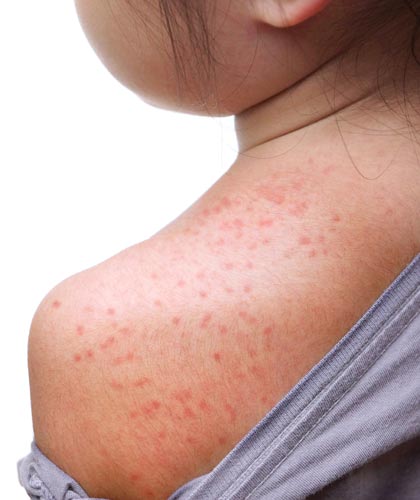Mold Exposure Symptoms: Can Mold Cause a Skin Rash?
If merely having a mold infestation doesn't give you the heebie-jeebies, knowing it can make you sick might. Mold can be a serious problem and, over time, can lead to mold exposure symptoms like headaches, allergies, and chronic inflammatory issues. But that is not all.
Can Mold Exposure Cause a Skin Rash?
The short answer is yes! Mold loves a damp environment, and the more time you spend in damp spaces, the better your chance of developing symptoms, which may very well include a mold-induced skin rash. Whether or not someone becomes ill from mold exposure depends on their general state of health-immunocompromised people, infants, and older adults are among those often more affected by mold exposure. And it is these individuals, along with those already suffering from mold allergies, who usually develop a mold skin rash.
How Can Mold Make Your Skin Itchy?
Here at Mold KO, we hear all the time about adverse reactions. While any kind of negative reaction may be unwanted, the itching associated with a mold skin rash is often reported as one of the most uncomfortable symptoms.
It's an immunological response that causes this severe itching, and what it means is that your body is creating chemical antibodies to fight off the mold spores that have made their way inside. This "allergic reaction" causes inflammation, redness, rash, and extremely itchy skin. And if you're feeling itching all over your body, it might be time to call in a mold remediation service to check things out.
Mold is nothing to be taken lightly. Toxic mold must be both diagnosed and removed correctly. Also, not all molds are created equal. So the first step is determining what kind of mold infestation you have.
What Types of Molds Cause a Skin Rash?
Mold is omnipresent in our environment. Although the number of variations remains a mystery, estimates range from tens of thousands to over 250,000. Most mold species don't have any adverse health impacts on the majority of the population; however, toxic molds release mycotoxins which give off symptoms like skin rash, allergy-like symptoms, neurological, and even digestive symptoms. Contrary to pathogenic and allergic molds, toxic molds discharge harmful toxins that are meant to cause harm to other organisms nearby. Mycotoxins get into your body through ingestion, physical contact with the skin, or respiration.
Here are four of the most common types of toxic mold often found in homes and businesses premises:
- Stachybotrys chartarum - "black mold," is a common form of poisonous mold that can cause mold sickness. Black mold thrives in hot, humid climates where there is regular exposure to moisture through water leaks, flooding, or other water damage.
- Aspergillus flavus - and other hazardous mold species can produce harmful mycotoxins called aflatoxins. They are frequently found on food products that have been stored for an extended period of time, but they can also be found inside in dust from carpets and floors, humidifiers, and HVAC fans, as well as on damp walls and wallpaper.
- Aspergillus fumigatus - is one of the most common molds. This fungus is airborne and can lead to mycotoxin poisoning both indoors and outdoors. In addition, this mold produces gliotoxin, a substance linked to autoimmune illness.
- Versicolor Aspergillus - is one of the most familiar types of molds. It not only grows under air conditioners but is frequently in carpeting too. This type of mold exposure sometimes leads to mycotoxin poisoning, which affects immunocompromised humans and pets too. This one has even been linked to pulmonary disease. Moreover, Sterigmatocystin, one of the mycotoxins produced by this fungus, is carcinogenic.
What a Mold Rash on Skin Can Look Like
In all honesty, it could be tough to differentiate a mold skin rash from other kinds of allergic rashes. Even your doctor may have a hard time telling just by looking at it, but there are a few signs that could indicate that your skin rash is caused by mold, like the following:
- itching
- dry, scaly skin
- raw and sensitive skin
- brown or pink skin
- small raised spots that may leak fluid
But mold can cause a variety of rashes. It's best to see a doctor if you're unsure whether your rash might be mold-related.
How to Treat Mold-Induced Skin Disorders
Again, it's important that if you suspect you have a rash caused by a mold infestation, you first see your doctor! A doctor can make a diagnosis by doing a series of tests and reviewing your medical history. Blood or skin tests may be needed to help determine if you have a mold allergy. If the reason for your skin rush will be determined by in-house mold, then the second is to have a mold remediation specialist, like Mold KO of Dallas, check your home and do the remediation if necessary.
As A Dallas Local, How Can You Protect Your Home from Mold?
The most important thing you can do in mold prevention is act quickly. Your timely reaction is vital to reducing any possible adverse health effects. Mold KO is located in beautiful Dallas, Texas, and we specialize in mold removal for Dallas and the surrounding areas. We will come to inspect and diagnose the problem during the mold remediation process. If we find mold (and you decide to proceed with our services), we will begin prepping and isolating the affected area for removal right away. After removal, we treat the affected areas. We aim to get you and your family back to your lives as quickly and safely as possible! Call Mold KO today to schedule your inspection.
